Make Myself at Home: Vacation View of a Welsh Castle
Raglan Castle in Wales

Address: Raglan, Monmouthshire, Wales
Status: Not on the market
When my kids were growing up, I came to assess the success of any outing by the lack of crises. If no one threw up or got hurt and we came home with the same number of kids that we started with? That was deemed a great vacation. I’m exaggerating, of course. There were adventures had and memories made, but a lack of nosebleeds and a dearth of name-calling was the base measure of success.
Flash forward to the present. This summer, my family embarked on a different generation’s summer escapade. My mom, Sally; my brother, Ed; my sisters, Angie and Sue; Sue’s partner, Yvonne; and I spent 10 days together in England and Wales, a very special trip to celebrate Mom’s 80th birthday, visit her childhood stomping grounds, and reconnect with relatives in both countries.
I have to admit, I started out figuratively holding my breath, hoping that we could all just get along for the duration. I love my family, but we are six independent adults, used to doing our own thing on our own time schedules. On this trip, we were in for a whole lot of together time.

But I needn’t have worried. Our week in London went swimmingly, and our three days in Wales were filled with hikes, cousins, special meals, and beautiful countryside spotted with sheep. On our last day in Wales, which was also our very last day of vacation, our cousins Penny and Joe took us to visit Raglan Castle. It was a Monday, and we had the place almost to ourselves.
I was looking forward to visiting the castle, soaking up its charm, and enjoying the surrounding countryside. I did all of those things, and it was awesome. As we explored, the architecture and ambience made me curious about the castle’s construction, its uses through the years, and its history. Before I knew it, I was reading a little bit and asking a lot of questions. I learned just enough to be dangerous, so here is my history lesson and house tour from summer vacation.
Construction of Raglan Castle began in the 1430s, relatively late as castles go, making it one of the last medieval castles to be built in Britain. While it was intended to protect and withstand attack, it was foremost a showplace, built primarily by Sir William ap Thomas, known as the Blue Knight of Gwent. Although the castle was modified over the ensuing centuries, his influence still shows. He was responsible for one of the most notable features of the castle: the hexagonal Great Tower.
After Sir William’s death in 1445, the castle passed to his son, also named William, who dropped the Welsh version of their name and took the surname Herbert. William Herbert added the grand entrance known as the Gatehouse, as well as a detail both decorative and utilitarian: the machicolations on top of the towers. Machicolations are openings that enabled defenders of the castle to drop objects onto attackers below. Sir William Herbert was named the Earl of Pembroke in 1468, becoming the first Welshman to enter English aristocracy.

The castle was passed down through generations and features were added and updated through the next two centuries. Although it was built more for show than for battle, Raglan withstood one of the last long battles of the English Civil War until it was ultimately seized in 1646. Today, Raglan Castle is maintained by Cadw, the entity responsible for preserving Welsh historic monuments.
Raglan Castle can be seen for miles. The Great Tower is the predominant feature of the castle, jutting out in front, to the left of the entrance. It’s surrounded by a moat, just like the castles in fairy tales. The sight of the tower, complete with its moat, was what made me fall in love with Raglan.
In its day, the approach to Raglan would have been even more impressive. Arriving on horseback, one would have had to ride around the bulk of the Great Tower to enter the castle through an imposing three-story gatehouse, which would have had a drawbridge. A huge cobblestoned courtyard lay inside, with kitchens and pantries beyond. Only after going through this courtyard and the adjacent fountain court would one have been able to access the entrance to the Great Tower. In our modern-day houses, we pay attention to flow and traffic patterns. It’s apparent that the flow at Raglan Castle was designed very deliberately to impress and to limit admission depending on visitors’ status.

Signs of status don’t stop there. Beyond the cobblestone courtyard lie the chapel and a room called the Long Gallery, which was the height of fashion at that time. As its name implies, this room was a long hallway where nobility could exercise by walking its length in inclement weather. The walls would have been covered with elaborate tapestries and artwork, and the windows would have framed the manicured grounds and gardens. As we walked the Long Gallery on our visit, we could still see carved stone figures around the fireplace opening, leaving hints of the grandeur even today.
In fact, many of the architectural details are still visible at Raglan. Plentiful holes in the walls were identified as gun loops. We learned that some of these gun loops were placed in impractical positions, more for décor than for true defense. Some of the most distinctive features of Raglan Castle are its windows. One bay window in particular, called the oriel window, was designed to shine light directly onto the table in the dining hall. Walking through the castle remains today, with its tall stone walls and elaborate window openings, it’s easy to imagine the grand feasts and finery that it held many centuries ago.

In the far corner of the castle, beyond the Long Gallery, is another tower with a grand staircase leading up to elegant apartments. As guests were called to dinner, they would line up based on their status and descend accordingly. Today, this staircase leads up to a narrower spiral staircase that opens to a landing at the top of the tower, with an expansive, north-facing view. Terraced hillsides are still visible signs of the elaborate sculpture gardens, water features, and deer park that surrounded the castle in its heyday.
I stood up in this tower and waved across the length of the castle to my sister Angie, who was at the top of the Great Tower. After climbing carefully down the staircase, I walked through the cobblestone courtyard to meet her and the others so we could continue exploring. The castle was big enough that we could have avoided each other, but on this last day of summer vacation, in this bucolic ancient setting, we wanted to enjoy the castle together and get just a little more family time.
Raglan Castle is one of 129 sites managed by Cadw (a Welsh word for “preserve”). Learn more at gov.wales/cadw or follow them on Facebook or Twitter.



